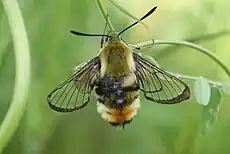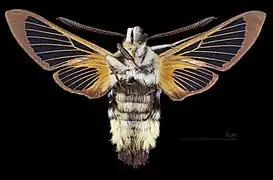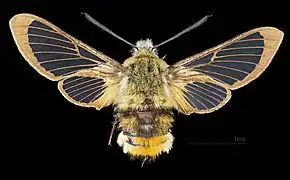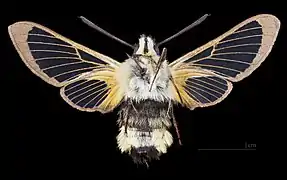Hemaris tityus
Hemaris tityus, the narrow-bordered bee hawk-moth, is a moth of the family Sphingidae which is native to the Palearctic.
| Narrow-bordered bee hawk-moth | |
|---|---|
 | |
| Scientific classification | |
| Domain: | Eukaryota |
| Kingdom: | Animalia |
| Phylum: | Arthropoda |
| Class: | Insecta |
| Order: | Lepidoptera |
| Family: | Sphingidae |
| Genus: | Hemaris |
| Species: | H. tityus |
| Binomial name | |
| Hemaris tityus | |
| Synonyms | |
| |
Range
It has a wide range, from Ireland across temperate Europe to the Ural Mountains, western Siberia, Novosibirsk and the Altai. It is also known from the Tian Shan eastwards across Mongolia to north-eastern China and southwards to Tibet. There is a separate population found from Turkey to northern Iran.
Biology
It appears in May and June and is a lively day-flier (unlike most other sphingids), generally active from mid-morning to mid-afternoon.[2] It frequents marshy woodland and damp moorland, and has a wide distribution across temperate Europe and Western Asia, but is generally quite scarce. The larvae feed on devil's-bit scabious (Succisa pratensis) and field scabious (Knautia arvensis).
Identification
It is distinguished from H. fuciformis by the narrow band of scaling along the outer wing margin, and the forewing's undivided discal cell. It has a wingspan of 40–50 millimetres (1.6–2.0 in). It is one of two similar species of sphingid moth occurring in Britain that closely mimic a bumblebee.
 Hemaris tityus ♂
Hemaris tityus ♂ Hemaris tityus ♂ △
Hemaris tityus ♂ △ Hemaris tityus ♀
Hemaris tityus ♀ Hemaris tityus ♀ △
Hemaris tityus ♀ △
Pictures
 Caterpillar and adult in John Curtis's British Entomology, Volume 5
Caterpillar and adult in John Curtis's British Entomology, Volume 5_caterpillar.jpg.webp) caterpillar, Romania
caterpillar, Romania.jpg.webp) Adult feeding
Adult feeding Figs. 4, 4a larvae after last moult
Figs. 4, 4a larvae after last moult
References
- "CATE Creating a Taxonomic eScience - Sphingidae". Cate-sphingidae.org. Archived from the original on 2012-11-10. Retrieved 2011-10-19.
- Pittaway, A. R. (2018). "Hemaris tityus (Linnaeus, 1758)". Sphingidae of the Western Palaearctic. Retrieved December 18, 2018.
External links
- "69.008 BF1982 Narrow-bordered Bee Hawk-moth Hemaris tityus (Linnaeus, 1758)". UKMoths.
- Description in Richard South: The Moths of the British Isles
- Lepiforum e.V.